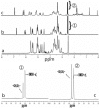Cholesterol-Modified Amino-Pullulan Nanoparticles as a Drug Carrier: Comparative Study of Cholesterol-Modified Carboxyethyl Pullulan and Pullulan Nanoparticles
- PMID: 28335293
- PMCID: PMC5224631
- DOI: 10.3390/nano6090165
Cholesterol-Modified Amino-Pullulan Nanoparticles as a Drug Carrier: Comparative Study of Cholesterol-Modified Carboxyethyl Pullulan and Pullulan Nanoparticles
Abstract
To search for nano-drug preparations with high efficiency in tumor treatment, we evaluated the drug-loading capacity and cell-uptake toxicity of three kinds of nanoparticles (NPs). Pullulan was grafted with ethylenediamine and hydrophobic groups to form hydrophobic cholesterol-modified amino-pullulan (CHAP) conjugates. Fourier transform infrared spectroscopy and nuclear magnetic resonance were used to identify the CHAP structure and calculate the degree of substitution of the cholesterol group. We compared three types of NPs with close cholesterol hydrophobic properties: CHAP, cholesterol-modified pullulan (CHP), and cholesterol-modified carboxylethylpullulan (CHCP), with the degree of substitution of cholesterol of 2.92%, 3.11%, and 3.46%, respectively. As compared with the two other NPs, CHAP NPs were larger, 263.9 nm, and had a positive surface charge of 7.22 mV by dynamic light-scattering measurement. CHAP NPs showed low drug-loading capacity, 12.3%, and encapsulation efficiency of 70.8%, which depended on NP hydrophobicity and was affected by surface charge. The drug release amounts of all NPs increased in the acid media, with CHAP NPs showing drug-release sensitivity with acid change. Cytotoxicity of HeLa cells was highest with mitoxantrone-loaded CHAP NPs on MTT assay. CHAP NPs may have potential as a high-efficiency drug carrier for tumor treatment.
Keywords: amino pullulan; cytotoxicity; degree of substitution; drug release; surface charge.
Conflict of interest statement
The authors declare no conflict of interest.
Figures










Similar articles
-
Effects of Particle Hydrophobicity, Surface Charge, Media pH Value and Complexation with Human Serum Albumin on Drug Release Behavior of Mitoxantrone-Loaded Pullulan Nanoparticles.Nanomaterials (Basel). 2015 Dec 25;6(1):2. doi: 10.3390/nano6010002. Nanomaterials (Basel). 2015. PMID: 28344259 Free PMC article.
-
Pullulan-Based Nanoparticle-HSA Complex Formation and Drug Release Influenced by Surface Charge.Nanoscale Res Lett. 2018 Oct 10;13(1):317. doi: 10.1186/s11671-018-2729-5. Nanoscale Res Lett. 2018. PMID: 30306404 Free PMC article.
-
Effect of pullulan nanoparticle surface charges on HSA complexation and drug release behavior of HSA-bound nanoparticles.PLoS One. 2012;7(11):e49304. doi: 10.1371/journal.pone.0049304. Epub 2012 Nov 14. PLoS One. 2012. PMID: 23166632 Free PMC article.
-
Hydrophobic amino acids grafted onto chitosan: a novel amphiphilic chitosan nanocarrier for hydrophobic drugs.Drug Dev Ind Pharm. 2017 Jan;43(1):1-11. doi: 10.1080/03639045.2016.1254240. Epub 2016 Nov 14. Drug Dev Ind Pharm. 2017. PMID: 27802776 Review.
-
Surface engineering of inorganic nanoparticles for imaging and therapy.Adv Drug Deliv Rev. 2013 May;65(5):622-48. doi: 10.1016/j.addr.2012.08.015. Epub 2012 Sep 6. Adv Drug Deliv Rev. 2013. PMID: 22975010 Review.
Cited by
-
Advances in Nano-Enabled Platforms for the Treatment of Depression.Polymers (Basel). 2021 Apr 29;13(9):1431. doi: 10.3390/polym13091431. Polymers (Basel). 2021. PMID: 33946703 Free PMC article. Review.
-
Modification of Poly(Glycerol Adipate) with Tocopherol and Cholesterol Modulating Nanoparticle Self-Assemblies and Cellular Responses of Triple-Negative Breast Cancer Cells to SN-38 Delivery.Pharmaceutics. 2023 Aug 8;15(8):2100. doi: 10.3390/pharmaceutics15082100. Pharmaceutics. 2023. PMID: 37631315 Free PMC article.
-
Pullulan nanoparticles inhibit the pathogenicity of Candida albicans by regulating hypha-related gene expression.Microbiol Spectr. 2024 Nov 14;12(12):e0104824. doi: 10.1128/spectrum.01048-24. Online ahead of print. Microbiol Spectr. 2024. PMID: 39540747 Free PMC article.
-
Novel Delivery of Mitoxantrone with Hydrophobically Modified Pullulan Nanoparticles to Inhibit Bladder Cancer Cell and the Effect of Nano-drug Size on Inhibition Efficiency.Nanoscale Res Lett. 2018 Oct 30;13(1):345. doi: 10.1186/s11671-018-2769-x. Nanoscale Res Lett. 2018. PMID: 30377872 Free PMC article.
-
Morphologically transformable peptide nanocarriers coloaded with doxorubicin and curcumin inhibit the growth and metastasis of hepatocellular carcinoma.Mater Today Bio. 2023 Dec 12;24:100903. doi: 10.1016/j.mtbio.2023.100903. eCollection 2024 Feb. Mater Today Bio. 2023. PMID: 38130427 Free PMC article.
References
LinkOut - more resources
Full Text Sources
Other Literature Sources
Research Materials
Miscellaneous

